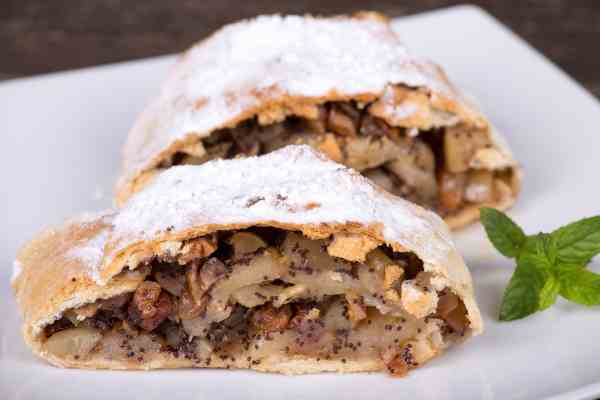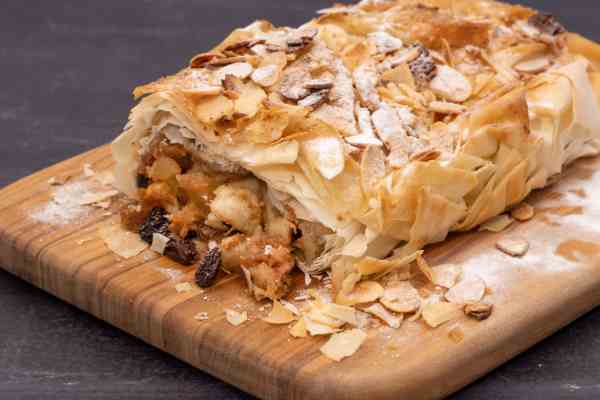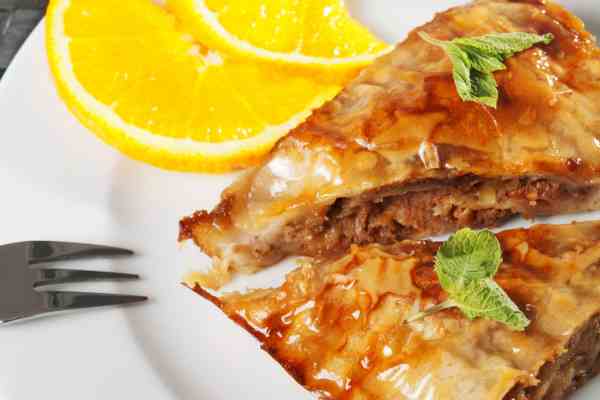Apple strudel, or "Apfelstrudel" in German, is a classic pastry that has become synonymous with German cuisine and culture. This sweet and flaky dessert is a staple at many German bakeries and cafes, and is often enjoyed as a warm and comforting treat during the colder months.
But apple strudel is more than just a delicious dessert - it's also a cultural icon that has played an important role in German history and tradition. In this comprehensive guide, we'll take a closer look at the origins and history of apple strudel, as well as the ingredients and preparation methods used to make this classic pastry.
We'll also explore the different ways in which apple strudel is served and paired with other foods and beverages, and examine some modern adaptations of this beloved dessert. Whether you're a seasoned apple strudel enthusiast or a newcomer to this tasty treat, this guide has everything you need to know about German apple strudel.
Learn more about the German pretzel and the sweet and wonderful Black Forest cake.
Origins and History
Strudel is a type of layered pastry that originated in Europe in the 18th century. It is believed to have been brought to Austria by Turkish soldiers, who introduced the technique of stretching dough paper-thin to make baklava. The Austrians adapted this technique to create their own layered pastry, which they called "strudel."
The first recorded mention of strudel in Austria dates back to the 18th century, when it was a popular dish among the Viennese aristocracy. At this time, strudel was typically made with a savory filling, such as cabbage or spinach.
It wasn't until the late 19th century that apple strudel became popular in Austria and Germany. The introduction of apples to the pastry was likely influenced by the popularity of apples in the region, as well as the availability of sugar and cinnamon.
Today, apple strudel is considered a staple of German cuisine, and is enjoyed by people of all ages throughout the country. It is often served as a dessert, but can also be enjoyed as a breakfast pastry or as a snack.
In addition to its culinary significance, apple strudel also holds a special place in German culture. It is often associated with the holiday season, and is a popular treat at Christmas markets throughout Germany. Apple strudel is also sometimes used as a symbol of German identity and tradition, and is a beloved pastry that has become an integral part of German cuisine and culture.
Ingredients and Preparation
German apple strudel is made with just a few simple ingredients, but the process of making it is intricate and requires skill and patience. Here is an overview of the traditional ingredients used in German apple strudel, as well as the step-by-step process for making it:
Ingredients
- Phyllo or strudel dough
- Apples (usually tart apples such as Granny Smith)
- Sugar
- Ground cinnamon
- Raisins
- Butter
- Bread crumbs
Preparation
- Preheat the oven to 375°F (190°C) and line a baking sheet with parchment paper.
- Peel and core the apples, and slice them thinly. Toss them with sugar, cinnamon, and raisins.
- Melt butter in a small pan, and add bread crumbs. Cook until the bread crumbs are golden brown.
- Lay a clean tablecloth on a large surface, and sprinkle it with flour. Place the phyllo dough on top of the tablecloth.
- Brush the phyllo dough with melted butter, and sprinkle with bread crumbs.
- Arrange the apple filling in a line along one edge of the phyllo dough, leaving about 2 inches of space on each side.
- Using the tablecloth to help you, carefully roll the strudel up tightly, tucking in the edges as you go.
- Brush the top of the strudel with melted butter, and sprinkle with sugar.
- Bake the strudel for 30 to 40 minutes, until it is golden brown and crispy on the outside.
Variations
While apple strudel is typically made using the traditional ingredients and preparation method described above, there are also many variations of the pastry that can be found throughout Germany. Some bakers add nuts, such as walnuts or almonds, to the filling for added texture and flavor. Others add a splash of rum or other spirits to the filling for a boozy twist.
In addition to these variations, there are also many regional differences in apple strudel preparation. For example, in some parts of Germany, the phyllo dough is made with sour cream or quark, which gives the pastry a tangy flavor. In other regions, strudel dough is made using potatoes instead of flour, which gives the pastry a denser texture.
Overall, while there are many variations and regional differences in apple strudel preparation, the pastry remains a beloved and iconic dessert in Germany, and is a testament to the country's rich culinary heritage.
Serving and Pairing
German apple strudel is typically served warm, straight from the oven. It can be enjoyed on its own as a dessert, or paired with a variety of accompaniments for a more substantial meal. Here are some traditional ways of serving apple strudel in Germany, as well as some popular accompaniments and beverage pairings:
Serving
- Dusted with powdered sugar
- Served with a dollop of whipped cream or vanilla ice cream
- Served with a side of warm vanilla custard
Accompaniments
- Coffee or tea
- Hot chocolate or cocoa
- Spiced apple cider
- Mulled wine or Glühwein (during the holiday season)
Pairing
In addition to traditional hot beverages, apple strudel can also be paired with a variety of alcoholic beverages. Here are some suggested pairings:
- Riesling or other crisp white wine
- Spätlese or other German late harvest wines
- Beer, particularly wheat beers or malty lagers
- Schnapps or other fruit brandies
Overall, the versatility of apple strudel makes it a great option for any time of day or occasion. Whether enjoyed as a sweet dessert or paired with a hearty meal and a cold beer, German apple strudel is a delicious and comforting pastry that can be enjoyed in many different ways.
Modern Adaptations
While traditional German apple strudel remains a beloved dessert, contemporary bakers and pastry chefs have put their own spin on the classic pastry. Here are some modern adaptations and creative twists on traditional apple strudel:
Contemporary Variations
- Savory strudel: Instead of a sweet filling, some chefs make a savory strudel with ingredients such as spinach, feta cheese, and sun-dried tomatoes.
- Miniature strudels: Some bakers make miniature apple strudels, which are bite-sized and perfect for serving at parties or events.
- Strudel bites: Similar to miniature strudels, strudel bites are small, bite-sized pieces of apple strudel that are easy to eat on the go.
Different Fruits and Flavors
- Pear strudel: Instead of apples, some bakers use pears as the main fruit in their strudel.
- Berry strudel: Berries such as raspberries, blueberries, and strawberries can also be used to create a delicious and fruity strudel.
- Nutella strudel: For a decadent twist on traditional apple strudel, some bakers use Nutella as a filling, adding hazelnuts for a delicious crunch.
Creative Twists
- Strudel cake: Some bakers have created a strudel cake, which is essentially layers of strudel pastry filled with fruit and cream, then topped with streusel.
- Strudel turnovers: A fun and portable twist on traditional apple strudel, turnovers are made with the same ingredients as strudel, but are folded into a triangular shape and baked until crispy and golden.
While these modern adaptations are different from traditional apple strudel, they still pay homage to the pastry's cultural significance in Germany. Whether you prefer a classic apple strudel or a modern twist on the pastry, there's no denying the delicious and comforting nature of this beloved German dessert.
Conclusion
German apple strudel is a classic pastry that has become a cultural icon in Germany. From its humble origins in Austria to its modern variations, apple strudel has endured as a beloved dessert throughout the centuries.
In this comprehensive guide, we explored the origins and history of apple strudel, its traditional ingredients and preparation methods, as well as its cultural significance in German cuisine and culture. We also delved into the different ways in which apple strudel is served and paired, and examined some modern adaptations of this classic pastry.
Whether you prefer your apple strudel served warm with a dollop of whipped cream or paired with a cold beer, there's no denying the delicious and comforting nature of this beloved German pastry. As a symbol of German identity and tradition, apple strudel has become an integral part of the country's rich culinary heritage.
So the next time you're in Germany, be sure to indulge in a slice of apple strudel and savor the taste of this iconic pastry. And for those who want to try making it at home, follow our step-by-step recipe and tips to create your own delicious apple strudel. Prost! (Cheers!)
Helpful Resources
https://www.helmuts-strudel.com/
https://www.thedelaunay.com/
https://en.wikipedia.org/
https://theculturetrip.com/
https://www.gamberorossointernational.com/






